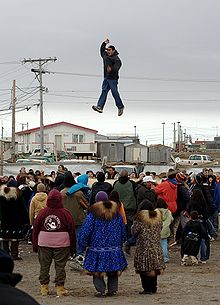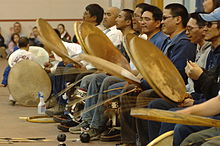- Nalukataq
-
Nalukataq (< naluk- 'to throw it underhand; to toss it up' + kataq) is the spring whaling festival of the Inupiaq Eskimos of Northern Alaska, and is characterized most famously by the Eskimo blanket toss.
After the spring whale hunting season, successful crews celebrate with a Nalukataq festival. These take place in June, and are scheduled to avoid conflicts between villages to allow friends and relatives from distant communities to share the bounty and the fun. In Barrow, for example, Nalukataq is usually in the third week of June. Other villages may be in the week before or the week after. Scheduling depends on how many whales were caught as well as other factors.
Nalukataq serves two purposes: First, it is a celebration of thanksgiving for success. Second, it is the first of several times during the year when quaq (frozen whale meat)[1] and muktuk (whale blubber and skin) are distributed to the community. The ability to produce and distribute wealth amongst the community is highly valued in Eskimo cultures, and whaling captains, who always give away large portions of their whales, gain great stature and respect within the village for every whale they catch.
Festive clothing is commonly worn to the event, and highly decorated mukluks and parkas of seal, caribou, wolverine, wolf, and fox are abundant.
There are several stages to the celebration. It begins with a prayer, and a raising of the crews' flags at around noon. Then bread, coffee, and initially various soups of goose and caribou are distributed. Following that, all of the food is one part or another of the whale. The flippers and certain of the guts of the whale are offered to visitors.
After a break, filled by singing and story telling, the whaling crews begin to distribute the catch to each family who attends the event. The amount which is given away depends on the size and number of whales harvested. First comes the quaq, which is whale meat frozen raw and cut into cubes. Next is the avarraq, the flukes of the whale cut into thin strips. Once these have been distributed, the various other cuts of muktuk are distributed frozen, with skin on. A hiatus of a couple of hours follows this, in which time everyone feasts on the catch.
In this interim period, the Nalukataq blanket is erected. It is made from several Bearded Seal skins sewn together in a circle or square. A rope extends from each corner, and is pulled tightly between four wooden beams using block and tackle. This raises the blanket to about waist height. Men and women circle the blanket and hold the edges, and pull out on the blanket to throw the blanket dancer in the air.
Anyone may be thrown on the blanket, but traditionally the captains and their wives go first. Originally they threw out goods, such as clothing, tools, or food as a means of demonstrating their ability to provide, but today that tradition has evolved, and wives of the captains throw candy to surrounding children once airborne. This event is the highlight and namesake of the festival, and may last several hours.
Following the blanket toss, everyone gathers for a traditional dance. Here, everyone is welcome to dance.
The beats are set by several men and boys with drums that traditionally were made from the skin of the liver or lungs of a whale, but today might also be made of synthetic materials. The men also sing songs for the dances. Following another prayer, the evening closes.
In addition to dances where everyone participates, there are usually dances by the organized dance group for that village. They sing traditional songs and perform what is essentially a "stage show" that delights everyone. The best front row seats are always reserved for elders.
Over the course of a couple of weeks, multiple Nalukataq celebrations may be held, and each of these may be put on by several captains. Barrow, due to its large population, has the most events, but Point Hope, Alaska and other villages along the North Slope also have several.[2][3]
See also
- World Eskimo Indian Olympics
- Arctic Winter Games
- Inuit
- Kaktovik, Alaska
- Nuiqsut, Alaska
- North Slope Borough, Alaska
- Aboriginal whaling
References
- ^ Eskimo Writing Key
- ^ Berit Arnestad Foote, The Tigara Eskimos and Their Environment, North Slope Borough Commission on Inupiat History, Language, and Culture, Point Hope, Alaska (1992)
- ^ "Uiniq – The Open Lead" Fall 1995, Volume 9, Issue 3, North Slope Borough
External links
Categories:- Inuit culture
- Festivals in Alaska
- North Slope Borough, Alaska
- Inupiaq words and phrases
Wikimedia Foundation. 2010.



